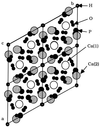Contaminant bioavailability in soils, sediments, and aquatic environments
- PMID: 10097045
- PMCID: PMC34276
- DOI: 10.1073/pnas.96.7.3365
Contaminant bioavailability in soils, sediments, and aquatic environments
Abstract
The aqueous concentrations of heavy metals in soils, sediments, and aquatic environments frequently are controlled by the dissolution and precipitation of discrete mineral phases. Contaminant uptake by organisms as well as contaminant transport in natural systems typically occurs through the solution phase. Thus, the thermodynamic solubility of contaminant-containing minerals in these environments can directly influence the chemical reactivity, transport, and ecotoxicity of their constituent ions. In many cases, Pb-contaminated soils and sediments contain the minerals anglesite (PbSO4), cerussite (PbCO3), and various lead oxides (e.g., litharge, PbO) as well as Pb2+ adsorbed to Fe and Mn (hydr)oxides. Whereas adsorbed Pb can be comparatively inert, the lead oxides, sulfates, and carbonates are all highly soluble in acidic to circumneutral environments, and soil Pb in these forms can pose a significant environmental risk. In contrast, the lead phosphates [e.g., pyromorphite, Pb5(PO4)3Cl] are much less soluble and geochemically stable over a wide pH range. Application of soluble or solid-phase phosphates (i.e., apatites) to contaminated soils and sediments induces the dissolution of the "native" Pb minerals, the desorption of Pb adsorbed by hydrous metal oxides, and the subsequent formation of pyromorphites in situ. This process results in decreases in the chemical lability and bioavailability of the Pb without its removal from the contaminated media. This and analogous approaches may be useful strategies for remediating contaminated soils and sediments.
Figures




Similar articles
-
Phosphate-induced lead immobilization from different lead minerals in soils under varying pH conditions.Environ Pollut. 2008 Mar;152(1):184-92. doi: 10.1016/j.envpol.2007.05.008. Epub 2007 Jun 29. Environ Pollut. 2008. PMID: 17601642
-
Transforming cerussite to pyromorphite by immobilising Pb(II) using hydroxyapatite and Pseudomonas rhodesiae.Chemosphere. 2022 Jan;287(Pt 2):132235. doi: 10.1016/j.chemosphere.2021.132235. Epub 2021 Sep 11. Chemosphere. 2022. PMID: 34826926
-
Petrographic and spectroscopic characterization of phosphate-stabilized mine tailings from Leadville, Colorado.Waste Manag. 2002;22(2):117-35. doi: 10.1016/s0956-053x(01)00060-5. Waste Manag. 2002. PMID: 12004827
-
Chelant extraction of heavy metals from contaminated soils.J Hazard Mater. 1999 Apr 23;66(1-2):151-210. doi: 10.1016/s0304-3894(99)00010-2. J Hazard Mater. 1999. PMID: 10379036 Review.
-
Phosphate application to firing range soils for Pb immobilization: the unclear role of phosphate.J Hazard Mater. 2007 Jun 1;144(1-2):1-14. doi: 10.1016/j.jhazmat.2007.02.008. Epub 2007 Feb 12. J Hazard Mater. 2007. PMID: 17360110 Review.
Cited by
-
Mineral surfaces and bioavailability of heavy metals: a molecular-scale perspective.Proc Natl Acad Sci U S A. 1999 Mar 30;96(7):3388-95. doi: 10.1073/pnas.96.7.3388. Proc Natl Acad Sci U S A. 1999. PMID: 10097048 Free PMC article.
-
Ecological risk assessment on heavy metals in soils: Use of soil diffuse reflectance mid-infrared Fourier-transform spectroscopy.Sci Rep. 2017 Feb 13;7:40709. doi: 10.1038/srep40709. Sci Rep. 2017. PMID: 28198802 Free PMC article.
-
Bioavailability of heavy metals in soil: impact on microbial biodegradation of organic compounds and possible improvement strategies.Int J Mol Sci. 2013 May 15;14(5):10197-228. doi: 10.3390/ijms140510197. Int J Mol Sci. 2013. PMID: 23676353 Free PMC article. Review.
-
Speciation of metals in bed sediments and water of Qaraaoun Reservoir, Lebanon.Environ Monit Assess. 2011 Jul;178(1-4):563-79. doi: 10.1007/s10661-010-1713-z. Epub 2010 Sep 25. Environ Monit Assess. 2011. PMID: 20865319
-
Bioavailable soil Pb minimized by in situ transformation to plumbojarosite.Proc Natl Acad Sci U S A. 2021 Jan 19;118(3):e2020315117. doi: 10.1073/pnas.2020315117. Epub 2020 Dec 21. Proc Natl Acad Sci U S A. 2021. PMID: 33431689 Free PMC article.
References
-
- Krauskopf K B, Bird D K. Introduction to Geochemistry. New York: McGraw-Hill; 1995.
-
- Hayes K F, Traina S J. In: Soil Chemistry and Ecosystem Health. Huang P M, editor. Madison, WI: Soil Sci. Soc. Am.; 1998. pp. 45–84.
-
- Newman M C, McIntosh A W. Metal Ecotoxicology Concepts and Application. Chelsea, MI: Lewis; 1991.
-
- Adriano D C. Biogeochemistry of Trace Metal. Chelsea, MI: Lewis; 1992.
-
- Iskandar I K, Selim H M. Engineering Aspects of Metal-Waste Management. Chelsea, MI: Lewis; 1992.
LinkOut - more resources
Full Text Sources
Other Literature Sources

